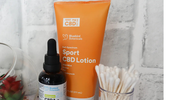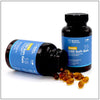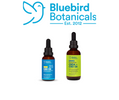Bluebird Botanicals Talks 2019 Wellness Trends

Self-care can be elusive in the modern world. From traffic on your daily commute to the real troubles that blindside you at 4 p.m. on some idle Tuesday, there are endless sources of stress woven into our daily lives. This is precisely why taking time to recharge and attend to your wellness needs is so important. At the same time, it seems like the self-care trends move at the same breakneck pace as the rest of society. Bluebird Botanicals is here to simplify your search for wellness by guiding you to the best and most prominent wellness trends we expect to see as the heat picks up this year — and how you can incorporate them into your self-care routine.
CBD

Due to changes in the laws regulating hemp, increased availability of products, and the plant’s more frequent and more truthful representation in media and mainstream culture, hemp products are beginning to overcome the strong taboos that have plagued them for decades. People are finally waking up to the value of CBD as a wellness product, and they are excited to share it with their friends and families.
In many ways, self-care also includes caring for your relationships and sharing what you have learned. So, if you’re looking for a thoughtful gift for your friends or loved ones (including your cat, dog, or other furry friend!), you might consider a CBD purchase for the purpose. Whether you’re looking for one of our 100% pure CBD extracts or something even more approachable like CBD oil capsules, we’re here to help you navigate your wellness journey this summer.
Ayurveda

Ayurvedic medicine, or ayurveda, is considered by many scholars to be the oldest healing science. Ayurveda means the “science of life.” Ayurveda places great emphasis on prevention and encourages maintenance of health through balance, mindfulness, diet, lifestyle, and herbalism. The two main principles are that the mind and body are inextricably connected, and nothing has more power to heal and transform the body than the mind. “Knowledge of Ayurveda enables one to understand how to create this balance of body, mind and consciousness according to one’s own individual constitution and how to make lifestyle changes to bring about and maintain this balance.” (The Ayurvedic Institute)
There are many facets to practicing Ayurveda and we could honestly dedicate a whole blog to it (maybe we will!). However, here are a few tips as told by Deepak Chopra:
- Eat a balanced diet. Balance is the keyword here. Ayurvedic medicine encourages a “rainbow diet” with foods of all colors and tastes. In fact, taste is quite important - it’s recommended to try to include elements of sweet, salty, pungent, sour, bitter, and astringent.
- Strengthen your digestive power. There are a lot of ways to do this, but Chopra suggests focusing on eating intentionally and slowly without distraction, minimizing raw foods, getting in daily moderate exercise, and practicing meditation.
- Get healthy sleep. A lack of restful sleep disrupts the body’s innate balance, weakens the immune system, and speeds up the aging process. Not everyone needs the same amount of sleep, but humans generally require six to eight hours. Read on for more tips to develop a healthy sleep cycle based on your own needs.
- From a Bluebird Ayurvedic practitioner – “If you’re unwilling to respect and honor what your being really truly needs, then there’s no point to practice.” This is perhaps the most important tip. Your body’s composition is determined at conception, which means your body’s true needs cannot be dismissed or ignored with excuses. Finding and restoring balance will likely require some lifestyle changes, and some of them may feel uncomfortable or difficult to stick to at first, like cutting out foods that don’t serve you or making yourself go to bed earlier. However, if you’re not willing to acknowledge and respect these needs, then you won’t get much out of your practice.
Circadian Rhythm Tracking

Yeah, this blog post is full of all kinds of weird words. The circadian rhythm is essentially your body’s internal 24-hour clock - also known as the sleep/wake cycle. It determines your energy levels throughout the day and regulates when you feel most alert versus sleepy.
Your circadian rhythm is partially determined by your brain (your hypothalamus, in particular), and partially determined by external factors like light and temperature. When you’re exposed to light, your brain releases cortisol, a stimulating hormone that makes you feel alert. Conversely, when it gets dark outside, your brain releases melatonin to tell your body it’s time to go to sleep.
If you pay close attention to your energy levels throughout various points of the day, you may very well be able to detect your own circadian rhythm at work. However, those who are sleep-deprived or have poor sleep routines, in general, may find it harder to tune into your body’s natural preferences for sleep. Here are some tips on tuning into your Circadian rhythm for healthy sleep:
- Turn off electronics. We’re not the first people to say this, but it’s important and there’s irrefutable evidence to prove it - excessive screentime before bed can seriously disrupt your sleep cycle. Try to turn off or put away electronics at least an hour before bed to give your brain some time to adjust. If your inbox just can’t handle that kind of solitude, try blue light blocking technology like Apple’s bedtime mode.
- There’s an app for that. Wait, didn’t we just tell you to put down the phone? While it may seem counterintuitive, many are finding success with utilizing sleep tracking apps to help set a schedule. Some devices like FitBit or the Apple Watch have a built-in sleep tracking feature, but there are also a whole host of others available.
- Get out in nature to regulate your sleep cycle: one weekend of camping can totally reset your body clock.
- Be disciplined. It may be difficult to shift from bad sleep habits to good ones, but it’s important to adhere to the goals and schedule you set for yourself. Even if it means sacrificing an hour of Netflix, the payoff of enhanced energy and mood will be worth it. Consistency is key, so keep at it!
Brain health

It’s no secret that the human brain is a powerful and complex organ. With the rise in prevalence of Alzheimer’s — nearly half of us will get the disease if we make it to 85 — alongside other neurodegenerative diseases, brain health has come into sharp focus.
Managing brain health can be just as complex as the organ itself. Everything from air pollution to spending time with our noses buried in devices can have an impact on our brain. It’s been shown that seeking out challenges that keep the brain nimble, like Sudoku or crosswords or learning a musical instrument.
While environmental factors may be difficult to control, another key area of focus with regards to brain health has been diet.
A healthy brain benefits from colorful, whole foods rich in beta-carotene and other goodies. Vibrant foods like blueberries and red onion can make an impact on staving off the effects of an aging brain. Remember that “rainbow diet” that’s popular in Ayurvedic medicine? Turns out it has many applications outside of ancient religions.
Post-exercise R&R

The wellness industry has taken off in recent years, which has led to an increased focus and effort among many young people on their health and fitness. With fitness models and exercise gurus filling Instagram feeds, athleticism is hitting the next level. However, it’s very easy for athletes to find themselves in a world of literal hurt if they don’t take proper recovery measures after workouts. In fact, many common sports-related injuries stem from inadequate muscle recovery and overexertion.
If you’re a dedicated athlete who’s not willing to take days off, here are some ways to incorporate some post-exercise R&R into your everyday routine.
- Ice baths or cryotherapy. This has been a popular post-workout treatment for a long time, but it’s still one of the hottest 2019 trends. And not without good reason. Taking a dip in some ice-cold goodness following a workout causes our blood vessels to become constricted, reducing swelling and inflammation. It also causes circulation to increase once you’re done with your frigid dip, which can effectively help flush the lymphatic system.
- Recovery/compression boots. Similarly to ice baths, compression boots help with healing and post-workout recovery. They work to increase circulation, improve mobility, and mitigate the swelling and other damage incurred through exercise.
- Stretching boutiques. Yes, you read that right. Assisted stretching is the new hot thing in the fitness world, and stretching studios or boutiques are where it’s all going down. Similarly to how a massage from someone else feels undeniably better than DIY-ing it, assisted stretching is supposed to take your post-workout recovery relaxation vibes to the next level.
- Infrared or red light therapy. This one’s truly out of this world. Spurned in part by NASA’s discovery that red light therapy activated natural plant growth in space, infrared therapy for muscle recovery has been proven to really work. Several studies have shown light therapy helps our bodies recover and regenerate muscle tissue quicker due to increased cellular energy and a reduction in oxidative stress. The American Journal of Physical Medicine and Rehabilitation even published a report demonstrating that light therapy can actually promote the growth of healthy muscle tissue, resulting in enhanced muscle size and strength.
- Lymphatic drainage massage. It’s not just for your sinuses! It’s been shown in several studies that manual lymphatic drainage can actually decrease athletic recovery time.
Financial health

Evolutionarily speaking, a bank account in the red sends the same threat message to your brain as coming face to face with a hungry predator. Which means that the prefrontal cortex - the area of the brain responsible for complex planning, personality expression, and decision making goes totally offline. Think fight, flight, or freeze here.
This is why financial health and wellness is such an important trend to follow in 2019 and keep going forward. Avoiding talking about or addressing financial situations - which, let’s be real, has been the norm until now - can actually increase stress hormones like cortisol and adrenaline. And long-term elevation of these hormones or long-term stress can have significant impacts on everything from mental health to cardiovascular disease to obesity and gastrointestinal problems.
But what does achieving financial health and wellness actually look like?
Let’s talk about it.
About 63% of Americans would struggle to pass a basic financial literacy quiz. This means we are largely not equipped with the knowledge or vocabulary to properly discuss finances, and we’re also afraid to ask. This can lead to larger problems than an individual not being able to make rent - it can actually act as a barrier to pay equity on a societal level, or even precede a divorce.
If you’re intimidated by putting your mouth where your money is, start in bite-sized chunks. Today, it might be emergency funds and tomorrow retirement funds. Before long, you could even be an expert investor. And, either way, leading a candid financial life will create a congruency that can cause your wellness to flourish.
Bluebird Botanicals prides itself on transparency, and you can with your financial health, too!










